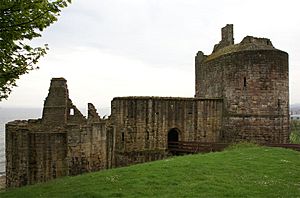Ravenscraig Castle facts for kids
Ravenscraig Castle is an old, ruined castle in Kirkcaldy, Scotland. It was built around 1460. This castle is special because it was one of the first in Scotland designed to defend against cannons.
Contents
History of Ravenscraig Castle
Building a Cannon-Proof Castle
King James II wanted Ravenscraig Castle built as a home for his wife, Mary of Guelders. He ordered the work to begin around 1460. The king was very involved in planning the castle. He wanted it to be strong enough to survive attacks from cannons. This made Ravenscraig one of the first castles in Scotland built specifically for artillery defense.
Sadly, King James II died in an accident with a cannon at Roxburgh Castle before Ravenscraig was finished.
Mary of Guelders and the Sinclairs
After the king's death, his wife, Mary of Guelders, continued building the castle. She wanted it to be a memorial to him and a place for her to live. Mary lived there until she passed away in 1463. At that time, only the east tower and the bottom part of the middle section were complete.
Ownership then went to her son, James III. In 1471, he traded the castle to William Sinclair, who was the Earl of Orkney and Caithness. In return, the King received the Earldom of Orkney lands. The Sinclair family finished building Ravenscraig Castle. They were also very interested in strong castle defenses.
Royal Visits and Later Years
Years later, King James V and his wife, Mary of Guise, visited Ravenscraig. This was on April 9, 1540, as they traveled to Falkland Palace. They arrived by boat, rowing from Kinghorn.
In 1650-1651, during a war in Scotland, English forces led by Oliver Cromwell attacked and damaged Ravenscraig Castle.
The Sinclair family continued to own the castle. They built a new house nearby called Dysart House in the 1700s. Later, the castle passed to the St Clair-Erskine family. In 1896, the castle and its land were sold to Sir Michael Nairn, a wealthy businessman.
Ravenscraig as a Public Park
During the First World War, Ravenscraig Castle was used to store ammunition. In 1929, the Nairn family gave 85 acres (about 34 hectares) of the estate, including the castle, to the town of Kirkcaldy. It became a public park for everyone to enjoy.
In 1955, the castle was taken care of by the state. Since 1971, it has been open to visitors. Today, Historic Environment Scotland manages Ravenscraig Castle. It is protected as a Scheduled Ancient Monument, which means it's an important historical site.
The band The Real McKenzies filmed a music video for their song "Drink Some More" at Ravenscraig Castle.
Exploring Ravenscraig Castle
Ravenscraig is a small castle built on a narrow, rocky piece of land that sticks out into the Firth of Forth. The sea cliffs protect three sides of the castle. The main part of the castle faces the land and forms its northern defense.
Strong Towers and Defenses
The castle has two D-shaped towers. Their outer walls are very thick, about 4.25 meters (14 feet) thick. These thick walls were designed to stop cannonballs. Between the towers, there was a platform for cannons, with gun holes pointing towards the land. A deep ditch, cut into the rock, also protected the castle. You would cross a bridge to enter.
Inside the Towers
The west tower has four floors. Each floor has one small room. On the ground floor, there's a vaulted cellar. Above that is a hall, which you reached by an outside stone staircase. A spiral staircase connected the upper floors. The wooden floors are gone now.
The east tower has three floors. It's built lower into the cliff. There's a well at the lowest level. Each floor above has a single room. A straight staircase inside the west wall connects the floors. The rooms in both towers have no windows facing the land because of the thick walls. But they have windows with stone seats on the other sides.
Connecting Buildings and Courtyard
The two towers are connected by a central building. This building holds the main gate and entrance passage. On either side of the passage, there are vaulted cellars and a guard room. These rooms support the cannon platform above. The gun holes are shaped like "inverted keyholes," which was a common design in the late 1400s. Beyond the main building, only the foundations of other structures remain on the rocky land.
Literary Inspiration: Rosabelle
Ravenscraig Castle is the setting for a famous poem called Rosabelle. It was written by Sir Walter Scott in his longer poem, Lay of the Last Minstrel.
The poem tells the story of a beautiful girl named Rosabelle, who is part of the St. Clair (or Sinclair) family. Despite warnings, she insists on taking a boat from Ravenscraig (which Scott calls 'Ravensheuch') across the Firth of Forth. She wants to attend a party at her family's main home, Roslin Castle, in Midlothian. Rosabelle knows that her parents and a special young man will be there.
However, that night, a strange light shines on Roslin Castle and the nearby chapel, where Rosabelle's ancestors are buried. Sadly, Rosabelle herself drowns in the sea.
An earlier member of the Sinclair family, Henry Sinclair I, who built the first Rosslyn Castle in the 11th century, was married to a woman named Rosabel.
Images for kids



